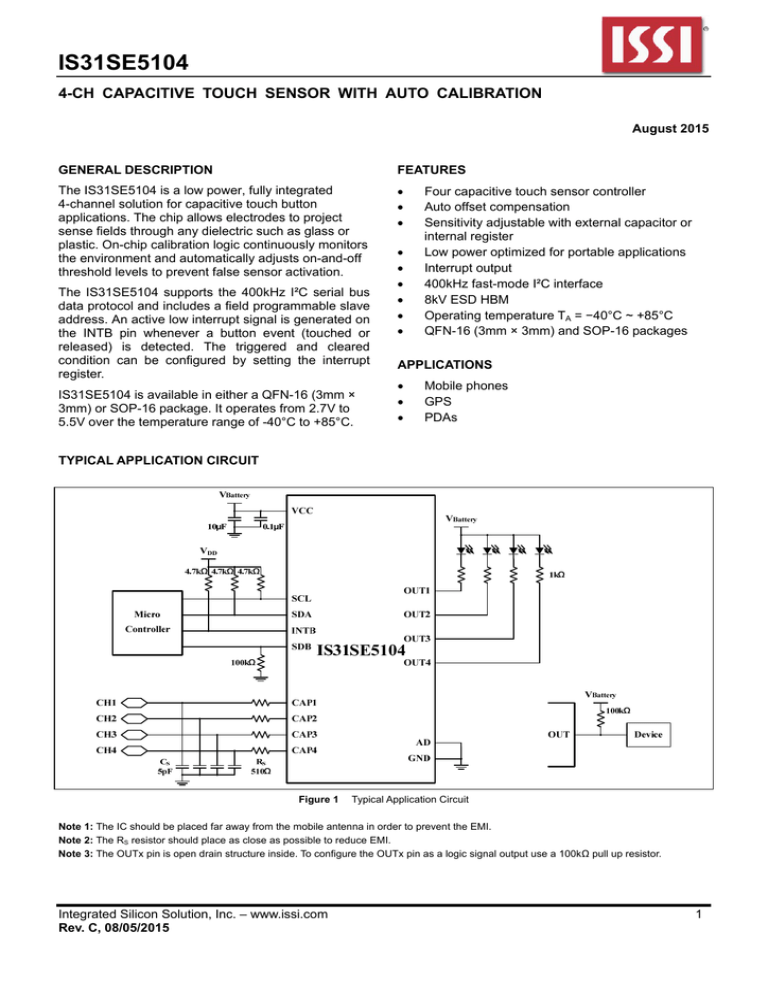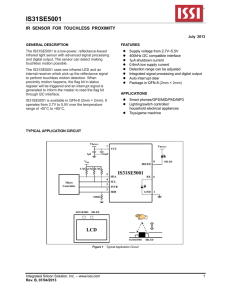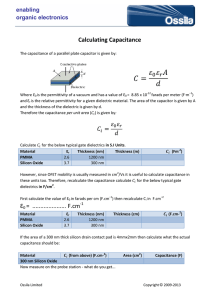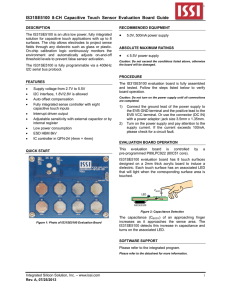
IS31SE5104
4-CH CAPACITIVE TOUCH SENSOR WITH AUTO CALIBRATION
August 2015
GENERAL DESCRIPTION
FEATURES
The IS31SE5104 is a low power, fully integrated
4-channel solution for capacitive touch button
applications. The chip allows electrodes to project
sense fields through any dielectric such as glass or
plastic. On-chip calibration logic continuously monitors
the environment and automatically adjusts on-and-off
threshold levels to prevent false sensor activation.
The IS31SE5104 supports the 400kHz I²C serial bus
data protocol and includes a field programmable slave
address. An active low interrupt signal is generated on
the INTB pin whenever a button event (touched or
released) is detected. The triggered and cleared
condition can be configured by setting the interrupt
register.
IS31SE5104 is available in either a QFN-16 (3mm ×
3mm) or SOP-16 package. It operates from 2.7V to
5.5V over the temperature range of -40°C to +85°C.
Four capacitive touch sensor controller
Auto offset compensation
Sensitivity adjustable with external capacitor or
internal register
Low power optimized for portable applications
Interrupt output
400kHz fast-mode I²C interface
8kV ESD HBM
Operating temperature TA = −40°C ~ +85°C
QFN-16 (3mm × 3mm) and SOP-16 packages
APPLICATIONS
Mobile phones
GPS
PDAs
TYPICAL APPLICATION CIRCUIT
Figure 1
Typical Application Circuit
Note 1: The IC should be placed far away from the mobile antenna in order to prevent the EMI.
Note 2: The RS resistor should place as close as possible to reduce EMI.
Note 3: The OUTx pin is open drain structure inside. To configure the OUTx pin as a logic signal output use a 100kΩ pull up resistor.
Integrated Silicon Solution, Inc. – www.issi.com
Rev. C, 08/05/2015
1
IS31SE5104
PIN CONFIGURATION
Package
Pin Configuration (Top View)
16 GND
15 OUT4
14 GND
13 OUT3
5
SCL 6
AD 7
SDA 8
SOP-16
CAP4
QFN-16
Integrated Silicon Solution, Inc. – www.issi.com
Rev. C, 08/05/2015
2
IS31SE5104
PIN DESCRIPTION
No.
Pin
Description
14,16
GND
Ground.
2
15
OUT4
Channel 4 outputs. Pulled low when input
sense channel is pressed. Leave floating if not
used.
4
1
VCC
Power supply.
5~8
2~5
CAP1 ~ CAP4
Input sense channel 1 ~ 4. Each channel
should connect to GND if it is not used and
disabled by the 01h register (Page 8).
9
7
AD
I2C address setting.
10
6
SCL
I2C serial clock.
11
8
SDA
I2C serial data.
12
9
INTB
Interrupt output, active low.
13
10
SDB
Shutdown the chip when pulled low.
14~16
11~13
OUT1 ~OUT3
Channel 1 ~ 3 outputs. Pulled low when input
sense channel is pressed. Unused channel
should be left floating.
Thermal Pad
Connect to GND.
SOP
QFN
1,3
-
Integrated Silicon Solution, Inc. – www.issi.com
Rev. C, 08/05/2015
3
IS31SE5104
ORDERING INFORMATION
Industrial Range: -40°C to +85°C
Order Part No.
Package
QTY
IS31SE5104-QFLS2-TR
QFN-16, Lead-free
2500/Reel
IS31SE5104-GRLS2-TR
IS31SE5104-GRLS2
SOP-16, Lead-free
2500/Reel
50/Tube
Copyright © 2015 Integrated Silicon Solution, Inc. All rights reserved. ISSI reserves the right to make changes to this specification and its products at any time without notice. ISSI assumes no liability arising out of the application or use of any information, products or services described herein. Customers are advised to obtain the latest version of this device specification before relying on any published information and before placing orders for products. Integrated Silicon Solution, Inc. does not recommend the use of any of its products in life support applications where the failure or malfunction of the product can reasonably be expected to cause failure of the life support system or to significantly affect its safety or effectiveness. Products are not authorized for use in such applications unless Integrated Silicon Solution, Inc. receives written assurance to its satisfaction, that: a.) the risk of injury or damage has been minimized; b.) the user assume all such risks; and c.) potential liability of Integrated Silicon Solution, Inc is adequately protected under the circumstances
Integrated Silicon Solution, Inc. – www.issi.com
Rev. C, 08/05/2015
4
IS31SE5104
ABSOLUTE MAXIMUM RATINGS
Supply voltage, VCC
Voltage at any input pin
Maximum junction temperature, TJMAX
Storage temperature range, TSTG
Operating temperature range, TA
ESD (HBM)
ESD (CDM)
-0.3V ~ +6.0V
-0.3V ~ VCC+0.3V
150°C
-65°C ~ +150°C
−40°C ~ +85°C
8kV
1kV
Note:
Stresses beyond those listed under “Absolute Maximum Ratings” may cause permanent damage to the device. These are stress ratings only and
functional operation of the device at these or any other condition beyond those indicated in the operational sections of the specifications is not
implied. Exposure to absolute maximum rating conditions for extended periods may affect device reliability.
ELECTRICAL CHARACTERISTICS
TA = -40°C ~ +85°C, VCC = 2.7V ~ 5.5V, unless otherwise noted. Typical value are TA = 25°C, VCC = 3.6V.
Symbol
Parameter
Condition
Min.
Typ.
Max.
Unit
5.5
V
VCC
Supply voltage
ICC
Quiescent power supply current
VSDB = VCC = 3.6V
173
476
μA
ISD
Shutdown current
VSDB = 0V, VCC = 5.5V
1.6
5.8
μA
VHR
Current Sink headroom voltage
IOUT = 20mA, VCC = 3.6V
290
467
mV
∆CS
Minimum detectable capacitance
CS = 5pF (Note 1)
2.7
79
pF
0.2
Logic Electrical Characteristics
VIL
Logic “0” input voltage
VCC = 2.7V
0.4
VIH
Logic “1” input voltage
VCC = 5.5V
IIL
Logic “0” input current
VINPUT = 0V(Note 1)
5
nA
IIH
Logic “1” input current
VINPUT = VCC(Note 1)
5
nA
1.4
V
V
DIGITAL INPUT SWITCHING CHARACTERISTICS (Note 1)
Symbol
Parameter
Condition
Min.
Typ.
Max.
Unit
400
kHz
fSCL
Serial-Clock frequency
tBUF
Bus free time between a STOP and a
START condition
1.3
μs
tHD, STA
Hold time (repeated) START condition
0.6
μs
tSU, STA
Repeated START condition setup time
0.6
μs
tSU, STO
STOP condition setup time
0.6
μs
tHD, DAT
Data hold time
tSU, DAT
Data setup time
100
ns
tLOW
SCL clock low period
1.3
μs
tHIGH
SCL clock high period
0.7
μs
0.9
μs
tR
Rise time of both SDA and SCL signals,
receiving
(Note 2)
20+0.1Cb
300
ns
tF
Fall time of both SDA and SCL signals,
receiving
(Note 2)
20+0.1Cb
300
ns
Note 1: Guaranteed by design.
Note 2: Cb = total capacitance of one bus line in pF. ISINK ≤ 6mA. tR and tF measured between 0.3 × VCC and 0.7 × VCC.
Integrated Silicon Solution, Inc. – www.issi.com
Rev. C, 08/05/2015
5
IS31SE5104
DETAILED DESCRIPTION
The 8-bit chip address is sent next, most significant bit
first. Each address bit must be stable while the SCL
level is high.
I2C INTERFACE
The IS31SE5104 uses a serial bus, which conforms to
the I2C protocol, to control the chip’s functions with two
wires: SCL and SDA. The IS31SE5104 has a 7-bit slave
address (A7:A1), followed by the R/W bit, A0. Set A0 to
“0” for a write command and set A0 to “1” for a read
command. The value of bits A1 and A2 are decided by
the connection of the AD pin.
After the last bit of the chip address is sent, the master
checks for the IS31SE5104’s acknowledge. The
master releases the SDA line high (through a pull-up
resistor). Then the master sends an SCL pulse. If the
IS31SE5104 has received the address correctly, then it
holds the SDA line low during the SCL pulse. If the SDA
line is not low, then the master should send a “STOP”
signal (discussed later) and abort the transfer.
The complete slave address is:
Table 1 Slave Address
Bit
A7:A3
A2:A1
A0
Value
10001
AD
1/0
Following acknowledge of IS31SE5104, the register
address byte is sent, most significant bit first.
IS31SE5104 must generate another acknowledge
indicating that the register address has been received.
AD connected to GND, AD = 00;
AD connected to VCC, AD = 11;
AD connected to SCL, AD = 01;
AD connected to SDA, AD = 10;
Then 8-bit of data byte are sent next, most significant
bit first. Each data bit should be valid while the SCL
level is stable high. After the data byte is sent, the
IS31SE5104 must generate another acknowledge to
indicate that the data was received.
The SCL line is uni-directional. The SDA line is
bi-directional (open-collector) with a pull-up resistor
(typically 4.7kΩ). The maximum clock frequency
specified by the I2C standard is 400kHz. In this
discussion, the master is the microcontroller and the
slave is the IS31SE5104.
The “STOP” signal ends the transfer. To signal “STOP”,
the SDA signal goes high while the SCL signal is high.
READING PORT REGISTERS
To read the device data, the bus master must first send
The timing diagram for the I2C is shown in Figure 2.
The SDA is latched in on the stable high level of the
SCL. When there is no interface activity, the SDA line
should be held high.
____
the IS31SE5104 address with the R/W bit set to “0”,
followed by the command byte, which determines
which register is accessed. After a restart, the bus
master must then send the IS31SE5104 address with
The “START” signal is generated by lowering the SDA
signal while the SCL signal is high. The start signal will
alert all devices attached to the I2C bus to check the
incoming address against their own chip address.
Figure 2
____
the R/W bit set to “1”. Data from the register defined
by the command byte is then sent from the
IS31SE5104 to the master (Figure 5).
Interface timing
Figure 3
Integrated Silicon Solution, Inc. – www.issi.com
Rev. C, 08/05/2015
Bit transfer
6
IS31SE5104
Figure 4
Figure 5
Integrated Silicon Solution, Inc. – www.issi.com
Rev. C, 08/05/2015
Writing to IS31SE5104
Reading from IS31SE5104
7
IS31SE5104
Table 2 Register Function
Address
Name
Function
Table
Default
00h
Configuration Register
Set software shutdown mode and sensitivity
3
0000 0000
01h
Channel Control Register
Set the 4 channels enable
4
1111 1111
02h
State Register 1
Store state of action for 4 channels
5
03h
State Register 2
Show state of 4 channels changes or not
6
04h
Interrupt Register
Set interrupt function
7
0000 0000
Table 5 02h State Register 1 (Read only)
Table 3 00h Configuration Register
Bit
D7
D6:D5
D4:D0
Bit
D7:D4
D3:D0
Name
SSD
SS
-
Name
-
AS4: AS1
Default
0
00
00000
Default
0000
0000
The Configuration Register sets software shutdown
mode and sensitivity.
The State Register 1 stores state of action for 4
channels.
SSD
0
1
Software Shutdown Enable
Normal operation
Software shutdown mode
ASx
0
1
SS
00
01
10
11
Sensitivity Selection
Normal sensitivity
High sensitivity
Low sensitivity
Not a valid state
Table 6 03h State Register 2 (Read only)
Table 4 01h Channel Control Register
Bit
D7:D4
D3:D0
Name
-
CH4: CH1
Default
1111
1111
The Channel Control Register sets the 4 channels
enable.
CHx
0
1
Channel Enable
Disable
Enable
Action State Bit
Button released
Button pressed
Bit
D7:D4
D3:D0
Name
-
SC4: SC1
Default
0000
0000
The State Register 2 shows state of 4 channels
changes or not.
State Change Bit
No state change
Button touched or released event occurs
SCx
0
1
Table 7 04h Interrupt Register
Bit
D7:D6
D5:D0
Name
ACI
-
Default
00
000000
The Interrupt Register sets interrupt function.
ACI
00
01
10
11
Integrated Silicon Solution, Inc. – www.issi.com
Rev. C, 08/05/2015
Automatically Clear Interrupt
No auto clear
Auto clear after 8ms
Auto clear after 32ms
Not a valid state
8
IS31SE5104
FUNCTIONAL BLOCK DIAGRAM
Integrated Silicon Solution, Inc. – www.issi.com
Rev. C, 08/05/2015
9
IS31SE5104
APPLICATION INFORMATION
GENERAL DESCRIPTION
The IS31SE5104 is an ultra low power, fully
integrated 4-channel solution for capacitive
touch-button applications. The chip allows electrodes
to project sense fields through any dielectric such as
glass or plastic.
SENSITIVITY ADJUSTING
Sensitivity can be adjusted by using an external
capacitor (Typical 5pF) or programming an internal
register.
A high value of capacitor will lower the sensitivity;
while a low value of capacitor will increase sensitivity.
The SS bit of Configuration Register (00h) is used to
modulate sensitivity. By setting the SS bit to “00”
sensitivity is normal. Sensitivity is high when SS bit is
set to “01”. Sensitivity is low when SS bit is set to “10”.
Setting SS bit to “11” is not a valid state.
OUTPUT CONTROL
There are 4 output ports (OUT1~OUT4) and 4
capacitive sensor input channels (CAP1~CAP4). The
output port will be pulled low to drive an externally
connected LED (with current limiting resistor) or other
device when a capacitance change is detected on
the corresponding input channel.
The OUT1~OUT4 ports are open drain type which
require a 100kΩ pull up resistor when used for logic
signaling.
For example, in Figure 1, when a sensitivity channels
detects a capacitance change, the corresponding
LED is driven by current set by the limiting resistor.
ACTION INFORMATION
The action information is stored in the State Register
(02h, 03h). If the AS bit is set to “0”, the
corresponding channel is released. If the AS bit is set
to “1”, the corresponding channels is pressed. If the
SC bit is set to “0”, the corresponding channel has no
status changing. If the SC bit is set to “1”, the
corresponding channel has status changing.
INTERRUPT SIGNAL
A detected capacitance change on any of the
CAP1~CAP4 inputs will cause the INTB pin to be
pulled low. The INTB signal is used for notifying the
MCU that a capacitance disturbance has been
detected. The MCU through the I2C bus can identify
which input experienced they capacitance change by
reading the Status Register (02h, 03h). The INTB will
return to high state once the MCU has accessed the
Status Register 2 (03h).
The ACI bit of Interrupt Register (04h) is used to
configure the automatic interrupt clear function. If the
ACI bit is set to “00”, the automatic interrupt clear
Integrated Silicon Solution, Inc. – www.issi.com
Rev. C, 08/05/2015
function is disabled. If the ACI bit is set to “01”, the
function is enabled and the INTB pin will be
automatically cleared after remaining low for 8ms. If
the ACI bit is set to “10”, the INTB pin will be
automatically cleared after staying low for 32ms.
Setting ACI bit to “11” is not a valid state.
AUTOMATIC CALIBRATION FUNCTION
The IS31SE5104 integrates an auto-calibration logic
block to continuously update the reference
capacitance register to compensate for slow changes
in the environment. Very low capacitive changes are
neutralized by the auto-calibration logic. The
advantage of auto-calibration is capacitive changes
due to dirt, humidity, or temperature will not affect this
device. However, extremely fast changes will not be
detected because the capacitance disturbance is
digitally filtered out.
An auto-calibration cycle is performed every 2
seconds. CAP1~CAP4 capacitance is measured
and the reference capacitance value in the hidden
registers are updated. A detection cycle is
performed every 16ms. The CAP1~CAP4
capacitance is measured and compared to the
stored reference capacitance. A valid detection is
when the CAP1~CAP4 capacitance differs from
the stored reference capacitance value for two (2)
detection cycles
The device can be programmed to 3 sensitivity
detection levels: Normal, High and Low. An
interrupt is generated if over two detection cycles
the measured capacitance exceeds the stored
reference value. A detection of 32 steps higher
difference is recognized as a capacitive change for
normal sensitivity, 16 steps higher for high
sensitivity and 64 steps higher for low sensitivity.
SHUTDOWN MODE
There are two methods to place the IC in shutdown
mode, software or hardware. The shutdown mode
can be used as a means of reducing power
consumption. During shutdown mode all registers
retain their data but capacitance changes are not
detected.
SOFTWARE SHUTDOWN
By setting SSD bit of the Configuration Register (00h)
to “1”, the IS31SE5104 will operate in software
shutdown mode. In this shutdown mode, the device
consumes only 1.6μA (typ.) current.
HARDWARE SHUTDOWN
The chip enters hardware shutdown mode when the
SDB pin is pulled low, wherein the consumption
current is the same as software shutdown, 1.6μA
(Typ.).
10
IS31SE5104
CLASSIFICATION REFLOW PROFILES
Profile Feature
Pb-Free Assembly
Preheat & Soak
Temperature min (Tsmin)
Temperature max (Tsmax)
Time (Tsmin to Tsmax) (ts)
150°C
200°C
60-120 seconds
Average ramp-up rate (Tsmax to Tp)
3°C/second max.
Liquidous temperature (TL)
Time at liquidous (tL)
217°C
60-150 seconds
Peak package body temperature (Tp)*
Max 260°C
Time (tp)** within 5°C of the specified
classification temperature (Tc)
Max 30 seconds
Average ramp-down rate (Tp to Tsmax)
6°C/second max.
Time 25°C to peak temperature
8 minutes max.
Figure 6
Classification profile
Integrated Silicon Solution, Inc. – www.issi.com
Rev. C, 08/05/2015
11
IS31SE5104
PACKAGE INFORMATION
QFN-16
Integrated Silicon Solution, Inc. – www.issi.com
Rev. C, 08/05/2015
12
IS31SE5104
SOP-16
Integrated Silicon Solution, Inc. – www.issi.com
Rev. C, 08/05/2015
13
IS31SE5104
RECOMMENDED LAND PATTERN
QFN-16
SOP-16
Note:
1. Land pattern complies to IPC-7351.
2. All dimensions in MM.
3. This document (including dimensions, notes & specs) is a recommendation based on typical circuit board manufacturing parameters. Since
land pattern design depends on many factors unknown (eg. user’s board manufacturing specs), user must determine suitability for use.
Integrated Silicon Solution, Inc. – www.issi.com
Rev. C, 08/05/2015
14
IS31SE5104
REVISION HISTORY
Revision
A
Detail Information
Date
Initial release
2013.12.25
B
1. Add Tape reel packing for SOP (Not release)
2014.11.10
C
1. Add land pattern
2. Add revision history
3. Revise Application Information
4. Update POD
2015.08.05
Integrated Silicon Solution, Inc. – www.issi.com
Rev. C, 08/05/2015
15





